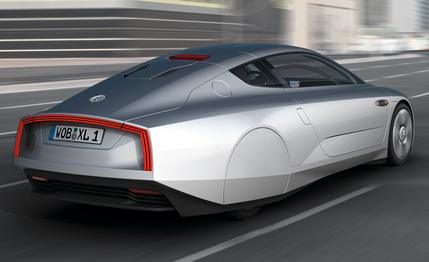
 Prototype Drive
Prototype Drive
So there we were in Qatar. This small emirate is reputed to have a per-capita GDP that ranks among the highest in the world. It has energy to spare, with plenty of oil and the world’s third-largest reserves of natural gas. The population produces three times as much carbon dioxide per person as does that of the United States. Premium gas costs the equivalent of just a dollar per gallon—and that’s after a recent 25-percent increase in the government-subsidized price, which caused serious consternation among the country’s V-8–packing drivers. The capital city of Doha is gridded with wide and heavily policed streets that run among seemingly endless construction sites, all adding to a Manhattan-like skyscraper forest.
It was in this environment that we were introduced to the hyperefficient Volkswagen XL1.
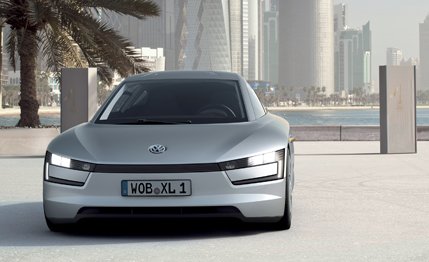

The Next Step for the “1-Liter” Car
The XL1 is Volkswagen’s latest “1-liter” car. This term doesn’t refer to engine displacement but rather to the European method of expressing consumption, which is to say the amount of fuel needed to travel 100 kilometers. Traveling that distance on one liter of fuel translates to 235 mpg—or, put differently, New York to Boston on one measly gallon of diesel. A 1-liter car would simply be the world’s most efficient combustion-engined passenger vehicle, and VW says the XL1 actually needs just 0.9 liter to travel 100 kilometers, which means the claimed maximum efficiency is a heady 261 mpg.
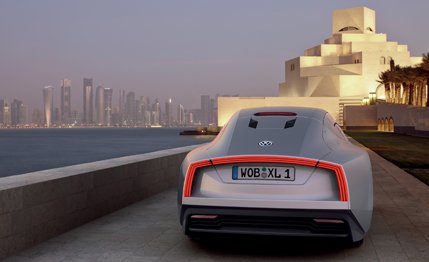

This VW is probably the first European car to have its world introduction preceded by thanks to Allah. Shortly after its debut at the first-ever Qatar auto show, the XL1 was examined by Sheikh Hamad Bin Jassim Bin Jabr Al-Thani, the country’s prime minister and minister of foreign affairs and a member of Qatar’s ruling family. His wife liked it and was reported as saying that she would like to have one. Most other visitors were bemused by the fuss over a little two-seater with a tiny engine and turned their attention to the Touareg Gold Edition, an exercise in 24-karat excess specially created for the local audience.
Why would Volkswagen even think about launching its most frugal car in a land where no one gives a second thought to saving energy? Simple: 17 percent of Volkswagen, Germany’s biggest car company, is now owned by Qatar Holdings, a part of the company’s sovereign wealth fund. It happened on the heels of Porsche’s failed bid to take over VW. Porsche had solicited investment from Qatar at the time of the Lehman Brothers collapse, when it held options on millions of Volkswagen shares. With Porsche instead becoming part of the Volkswagen Group, the Qatari investment turned into a chunk of VW.
Yet Another Piëch Brainchild
The 1-liter car was Ferdinand Piëch’s idea, and he drove the first concept, a cigar-shaped tandem two-seater, to the 2002 board meeting at which he retired as CEO. The intervening years produced a “2-liter” prototype that was only shown internally, as well as the L1 that appeared at the 2009 Frankfurt show. VW became convinced during that time that a production 1-liter would require a plug-in hybrid drivetrain. It would also need to have the lightest possible chassis and body panels, worldbeating aerodynamics, and side-by-side rather than tandem seating.
The XL1’s hybrid system consists of a 47-hp, 800-cc two-cylinder TDI turbo-diesel engine, a 27-hp (20-kW) electric motor, and VW’s seven-speed DSG dual-clutch gearbox. (The DSG is programmed to operate only in automatic mode.) The TDI and the electric motor combine to deliver maximum torque of 103 lb-ft. This amazingly compact powertrain is mounted transversely behind the passenger compartment and drives the rear wheels. A 5-kWh lithium-ion battery pack and a 2.6-gallon diesel fuel tank are nestled between the powertrain and passenger compartment.
The major factor in weight saving was the use of carbon fiber for the chassis and body panels. The center monocoque/safety cell is molded in one piece by a rapid resin-transfer process that’s quicker and cheaper than conventional hand-laid carbon. VW developed it with the Austrian company Carbo Tech, which also helped implement a similar system for the McLaren MP4-12C supercar. The supercar connection doesn’t end there: The XL1’s supersmooth, aerodynamically optimized shape should achieve an extremely low drag coefficient of 0.19.
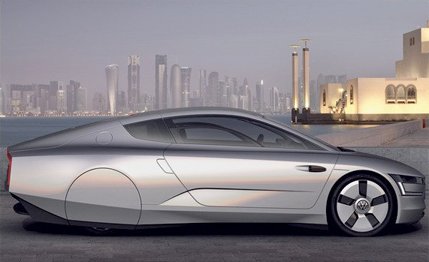

About as Poky as You’d Expect
So the XL1 looks racy, but its ultimate performance is leisurely: 0 to 60 mph takes about 11.5 seconds, and top speed is limited to 99 mph. Considering the elaborate and expensive weight-saving measures, the XL1 is heavier than one might expect, at 1800 or so pounds. Its predecessor, the L1, came in at a claimed 840 pounds. Blame the twofold increase on the safety equipment and the comfort and convenience features required to turn a vehicle solely focused on efficiency into an acceptable everyday car.
Even though it ditches earlier versions’ tandem seating, the XL1 remains narrow and tapers at the rear, so the passenger seat isn’t aligned with the driver’s; it’s offset toward the stern by a few inches to preserve shoulder room. There is, of course, none of the sound and fury of the supercars that pioneered this car’s construction methods. As with other vehicles that can operate purely on electricity, everything is remarkably quiet at step-off and at low speeds—all you hear is the thrum of tires on asphalt. Once you press harder on the accelerator to demand more power, the diesel engine starts, without any jolt but with a curious tinny rattle. Lift the pedal, and the gentle calm returns as the engine stops instantly; it restarts in milliseconds when you flex your right foot again.
You can, however, force the car to run only on electricity. Select that mode, and the TDI diesel is declutched from the drive wheels, at which point the XL1 can run for a claimed 22 miles and reach a top speed of 50 mph. Recharging the batteries via a plug takes an hour and a few cents. But the XL1 won’t leave you stranded. Like the Chevrolet Volt’s gasoline engine, the VW’s diesel powerplant takes over when the batteries reach a minimum charge level.
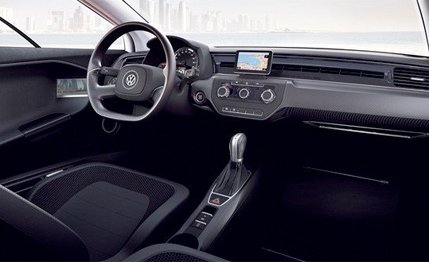

An Everyday Space Pod?
Hunkering down into the carbon-fiber driver’s seat feels special, and you’re confronted by a small steering wheel squared off at the bottom and a well-equipped and nicely trimmed dashboard. The XL1 has no rear window or side mirrors; in place of the latter, video cameras feed two small screens in the inner door panels. Design-wise, the interior is immediately recognizable as a VW. Onlookers, seeing the doors hinge upward as we climbed aboard, asked if it were a baby Lamborghini. Not quite, we replied, although some at Volkswagen believe, perhaps optimistically, that cars like this will be the supercars of an energy-conscious future.
Our drive through the city and outskirts of Doha suggested that the XL1 would be an acceptable daily driver. This in spite of a rather lumpy ride. Blame the narrow Michelin low-rolling-resistance tires, which run at a firm 45 psi. But the XL1 steers accurately and easily, without the need for power assistance. The brakes are fitted with lightweight carbon-ceramic discs and offer excellent stopping power, although less experienced pilots—or, ahem, younger ones—may find the pedal’s feel odd, as it’s as unassisted as the steering, a rarity in modern vehicles.
You’d need many miles behind the wheel or finely calibrated equipment—neither of which was available to us that day—to verify the official fuel-economy figure, which was calculated by the European authorities using a new drive cycle for plug-in hybrids. The number reported was a bit better than VW expected, at the equivalent of 261 mpg. So here is a car, primarily driven by a diesel engine, with minimal emissions (24 g/km of CO2 versus, say, the Prius’s 89 g/km) that can claim to be more efficient than more highly vaunted pure-electric vehicles.
For now, all the XL1 does is make a statement—it’s still a prototype. But VW Group chairman Martin Winterkorn promised it will be available by 2013 “at an affordable price.” We guess that will be somewhere around the equivalent of $50,000. Qatar won’t get it—and the U.S. probably won’t, either—but this is just the thing European eco-warriors have been waiting for.